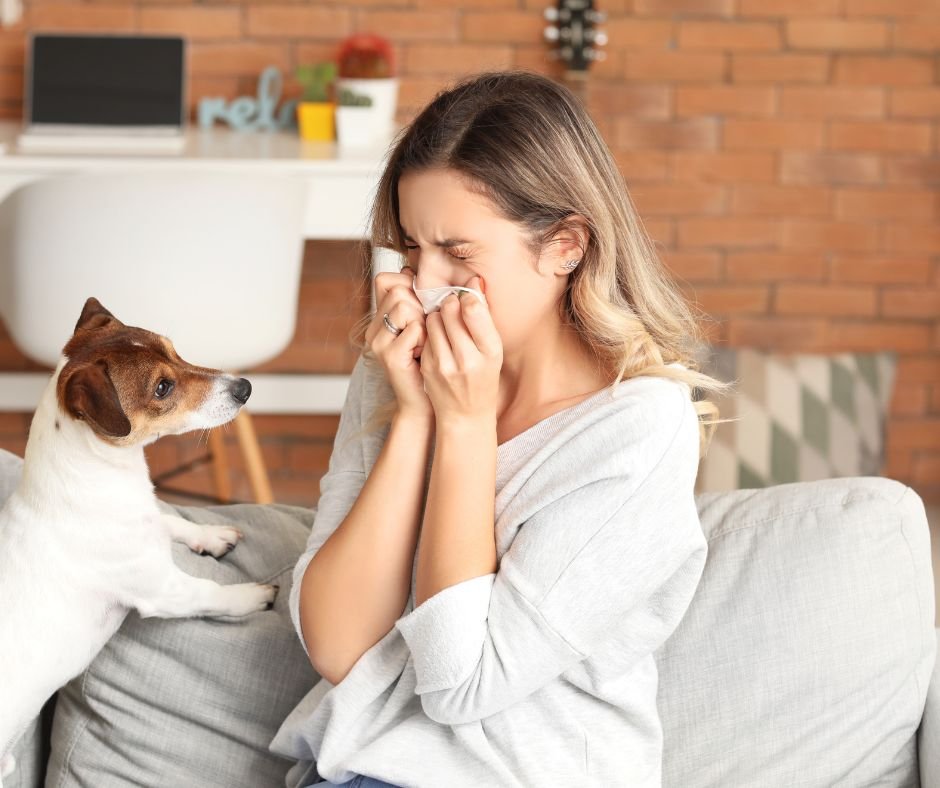
Pet allergies occur when the immune system of an infected person deals with the proteins secreted by the bodies of some animals as harmful and irritating substances. This results in a strong immune reaction when exposed to those proteins that exist in dead skin cells falling from animals, their saliva, or urine, which is usually attached to animal fur that causes allergies. This article provides you with all you need to know about pet allergies.
Animal fur in itself does not cause allergies. But it helps spread allergens that stick in the air on carpets and furniture. This allergy results from domestic pets such as cats and dogs. Infection with pet allergies leads to symptoms similar to those of seasonal allergies. The danger of continuous and long-term exposure to allergens may lead to a chronic allergy in a person which can develop into asthma attacks.

The following symptoms appear in people who suffer from pet allergies. They are:
We should note that the symptoms become worse if the person already suffers from respiratory problems such as asthma. If the allergy has a connection to asthma, you may suffer from the following symptoms:
The primary causes of pet allergies are cat and dog allergens that we find in the skin cells they shed (the dander), as well as the animal’s saliva, urine, sweat, and fur. Lint is a particular problem because it is so small. It can remain in the air for long periods of time if there is minimal air circulation. Lint can also get caught easily in upholstered furniture and can stick to your clothes.
Pet saliva can stick to carpets, bedding, furniture, and clothing. Dry saliva can fly in the air.

Hypoallergenic cats and dogs may shed less dander than other species. But there are really no non-allergic breeds.
Pet rodents include mice, jerboas, hamsters, and guinea pigs. In rodents, allergens typically exist in hair, dander, saliva, and urine. Dust from dirt or sawdust at the bottom of cages may contribute to the airborne dispersal of rodent allergens. In rabbits, allergens exist in dander, hair, and saliva.
The followings are some of the complications of pet allergy:
The diagnosis of pet allergies is carried out by one of the following tests:
The doctor chooses the appropriate treatment for each person based on the symptoms he suffers from. The type of medication that he can administer to the patient are:
Oral decongestants can increase blood pressure and shouldn’t be taken if you have high blood pressure, glaucoma, or cardiovascular disease. Talk to your doctor about whether you can safely take decongestants.
Over-the-counter nasal spray decongestants may reduce allergy symptoms for a short time. If you use a decongestant spray for more than three days, it can cause nasal congestion.

Every week, you take one or two injections you containing small doses of the allergen. In this case, the animal protein that causes the reaction becomes less effective over time. The dose is gradually increased, over a period of usually 4 to 6 months.
If you are making your own brine, use sterile, distilled water that is free of contaminants. You can either boil and cool it before use or filter it through a pore filter with an absolute opening size of one micron or less. Also, make sure to rinse the irrigator after each use with clean water, and leave it open to air dry.
Sometimes a person may not know if he suffers from allergies or from the symptoms of the common cold. If the symptoms persist for two weeks or more, it will be allergy symptoms and not cold symptoms.
The person should see a doctor if symptoms, such as difficulty breathing, severe nasal congestion, and sleeping difficulty are severe. If these symptoms worsen quickly, you must go straight to the emergency service in the hospital.
Here are some tips that you can follow to reduce the risk of pet allergy:
Leave a comment